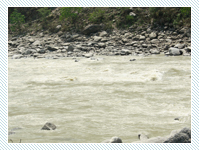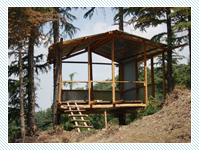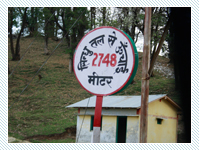MUNSYARI, Pithoragarh, Uttarakhand, India
 A neat small town in Johar Valley it is surrounded by magnificent snow clad peaks, crystal clear lakes and dense forests. Five gaps carved by adjacent peaks are famously known as the oven of the Pandavas, and termed as Panchachulli. Get mesmerized by a panoramic view of peaks like Nandakot, NandaGhunti, Rambha and Shiplakot, which keep changing color throughout the day ranging from pink to golden and turn magical silver during moonlit nights. A neat small town in Johar Valley it is surrounded by magnificent snow clad peaks, crystal clear lakes and dense forests. Five gaps carved by adjacent peaks are famously known as the oven of the Pandavas, and termed as Panchachulli. Get mesmerized by a panoramic view of peaks like Nandakot, NandaGhunti, Rambha and Shiplakot, which keep changing color throughout the day ranging from pink to golden and turn magical silver during moonlit nights.
If majestic snow clapped peaks, crystal clear lakes, dense forests of oak, deodar, rhododendron and pine, gushing brooks are blended together, the result will be a cocktail called Munsyari, a small town in Johar valley on the bank of Gori Ganga at the base of Panchachulli peaks of Kumaon Himalayas in Pithoragarh district. The five gapes carved by towering peaks are said to be oven of Pandavas, hence called Panchachulli. Munsyari presents a panoramic view of peaks like Nandakot, NandaGhunti, Rambha and Shiplakot. These peaks keep on changing their hue and color from red and pink in the morning to pale yellow and golden in the evening. The sight of dazzling silver peaks on moonlit nights is mesmerizing experience.
 Munsyari was hub of trade with Tibet before 1962 which was the basis of traditional prosperity of Bhotia Tribes. But with the closure of Indo-Tibet border few people are left in the villages and rest are migrated to bigger towns in search of livelihood. Still the skilled locals produce highly quality artistic woolen shawls, pashmina, dan (carpets), thulmas (quilt), pankhi (light blanket) etc. Mostly women folks are engaged in weaving. The art is passed on to generations without any formal training. Munsyari was hub of trade with Tibet before 1962 which was the basis of traditional prosperity of Bhotia Tribes. But with the closure of Indo-Tibet border few people are left in the villages and rest are migrated to bigger towns in search of livelihood. Still the skilled locals produce highly quality artistic woolen shawls, pashmina, dan (carpets), thulmas (quilt), pankhi (light blanket) etc. Mostly women folks are engaged in weaving. The art is passed on to generations without any formal training.
The rich culture of Bhotia tribe is evident from their traditional ceremonies and festivals. The village folks sing and dance in their traditional attire. Women have organized themselves and formed various associations. The Bhotias are born mountaineer and earned lot of fame in the field. Famous mountaineers H C S Rawat and Hukam Singh Pangti belong to Johar valley.
 Munsyari is a bird watcher's paradise. Exotic birds like wild sparrows, jays, whistling thrushes, finches, hawk cuckoos, Himalayan bulbuls, and blue magpie robins are abundantly found in the hills and forests of Johar valley. Munsyari is a bird watcher's paradise. Exotic birds like wild sparrows, jays, whistling thrushes, finches, hawk cuckoos, Himalayan bulbuls, and blue magpie robins are abundantly found in the hills and forests of Johar valley.
Munsyari is also famous for herbs and medicinal plants. Jambu and Gandharayan having medicinal properties are the essential spices of traditional cuisines.
SIGHTSEEING MUNSAYARI
A variety of day excursions to different locations in and around the valley are possible. For guests who are keen to burn some of their calories following places are woth trekking up to: Maheshwari Kund, Betulidhar, Thamari Kund, Balati Farm.
The Tribal Heritage Museum houses ancient artifacts painstakingly collected by Dr. Sher Singh Pangti, a local resident. These exhibits portray the life styles of the original inhabitants of the Johar valley and their moments of past history.
Located 4 kms from the resort is Darkot, a small picturesque hamlet. Residents of this village continue to live in traditional stone houses with slate roofs, some of which are more than one hundred years old. The old artistic houses of Darkot represent the rich culture and creativity of the people ofMunsiyari. If you are discerning shopper then do buy pashima, shawls and sheepwool blankets from here. The locals are known for their great weaving skills.
Gori-ganga is a river that originates from the snout of Milam glacier. It is also fed by glaciers and streams flowing from the eastern slopes of the east wall of the Nanda Devi Sanctuary, and those flowing west from the high peaks of Panchachulli. There are several spots along the banks of the river that are ideal for day picnics.
HOW TO REACH MUNSYARI
Distance from Delhi: 612 Kms, Distance from Nainital: 295 Kms
Nearest Airport: Pantnagar 340 Kms
Nearest Railhead: Kathgodam 303 Kms
Temperature: Max. 22°C. Min 0°C
Location Identified
|


